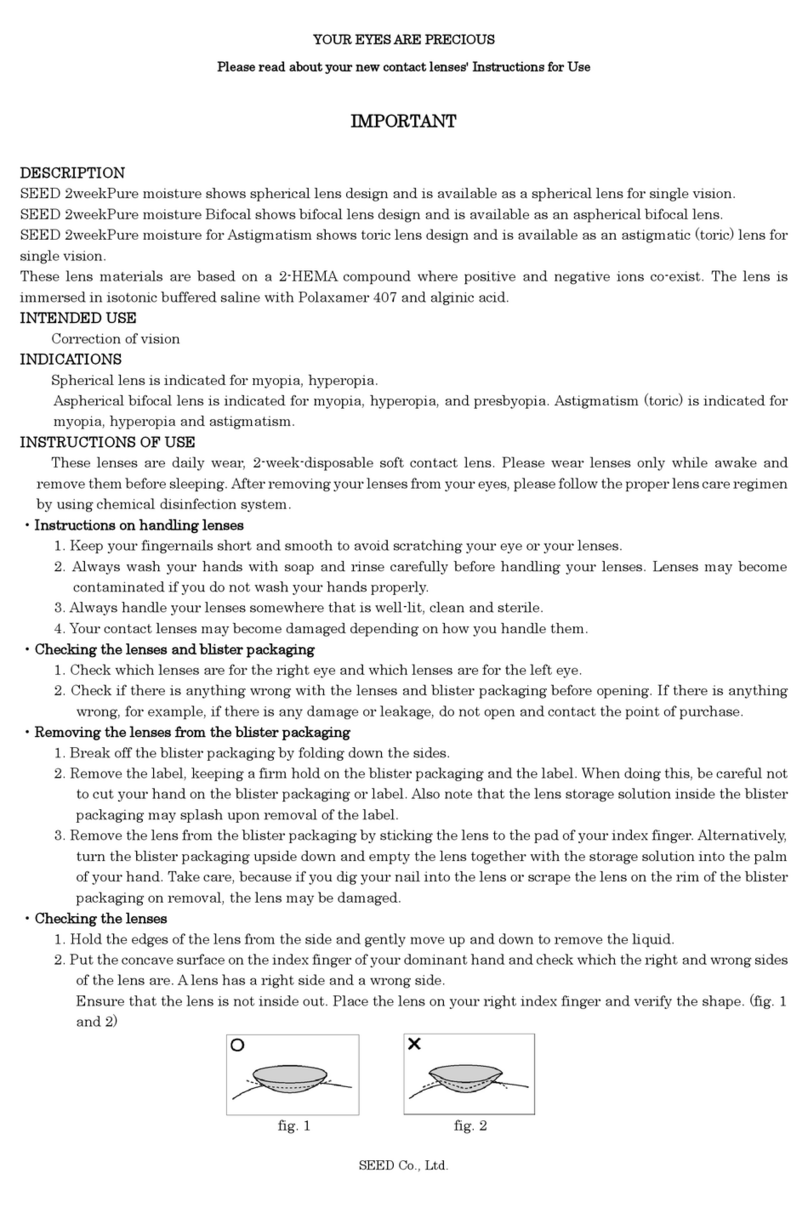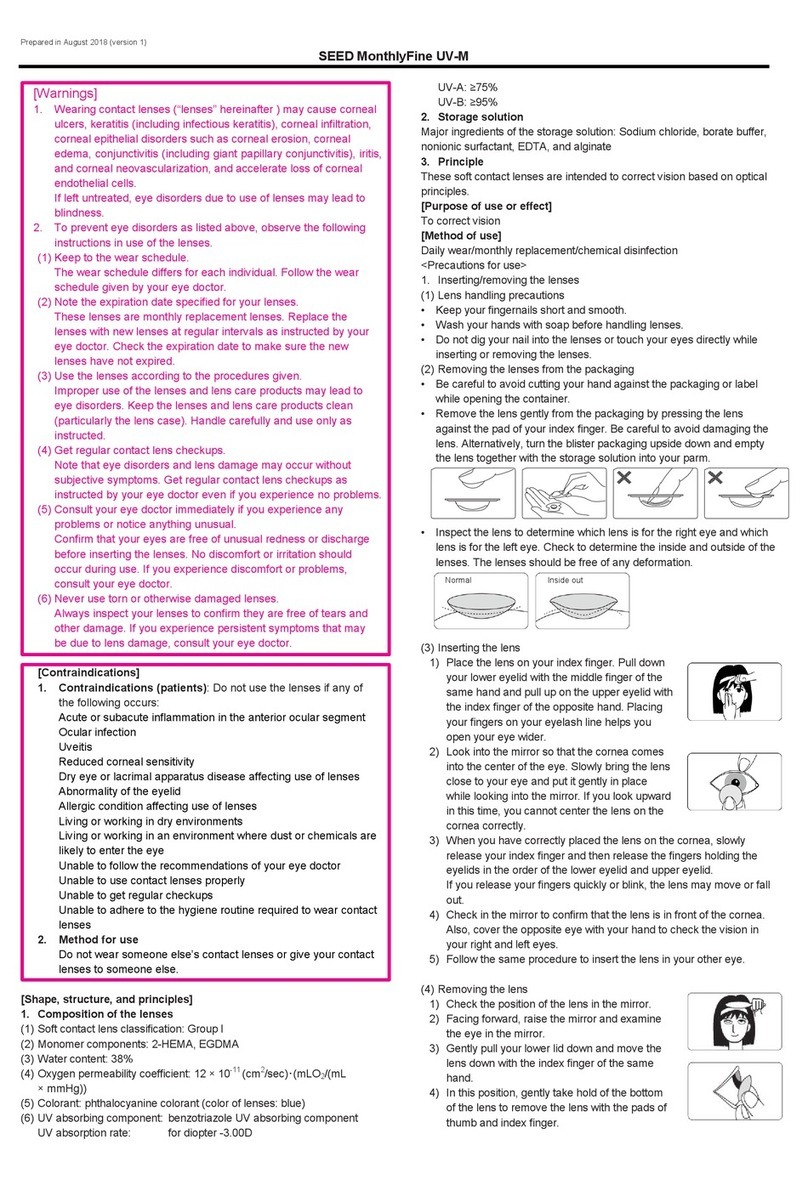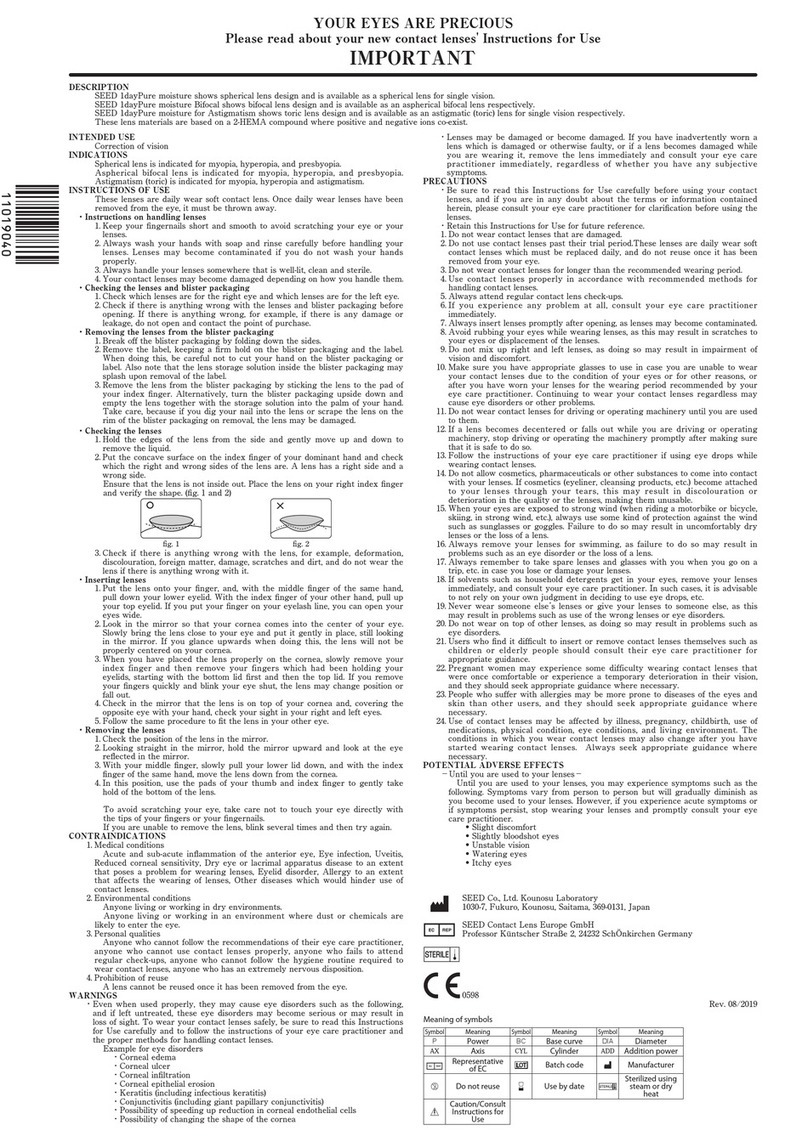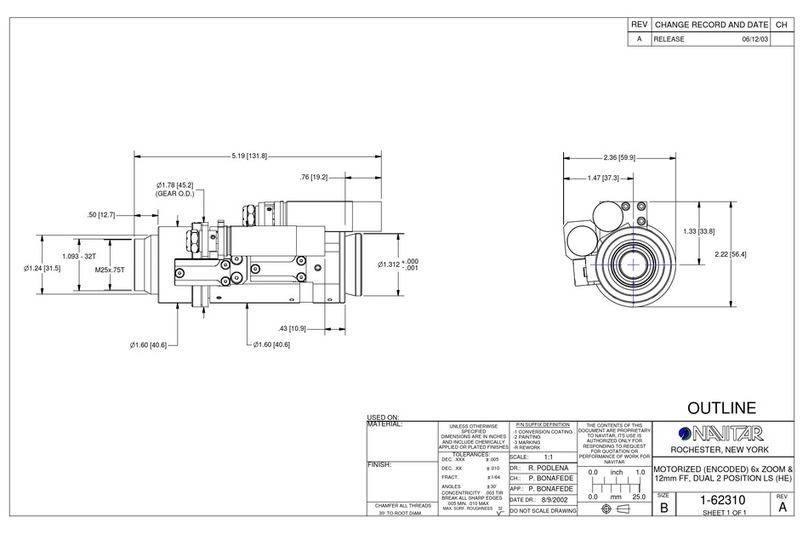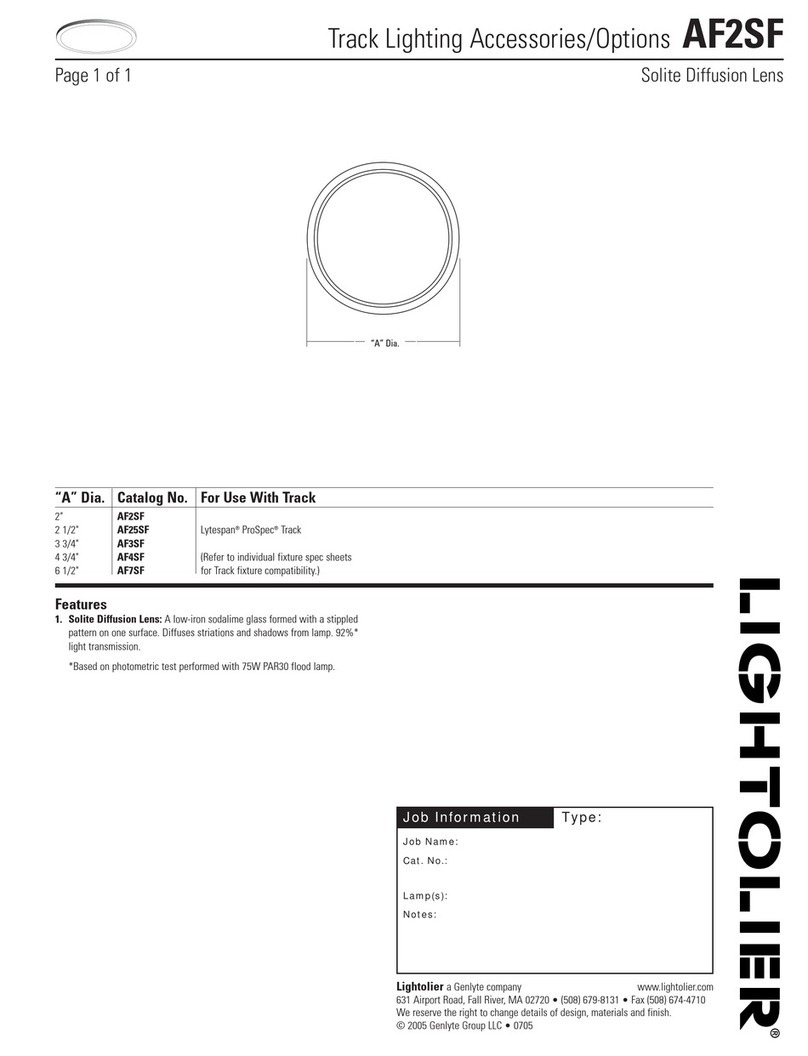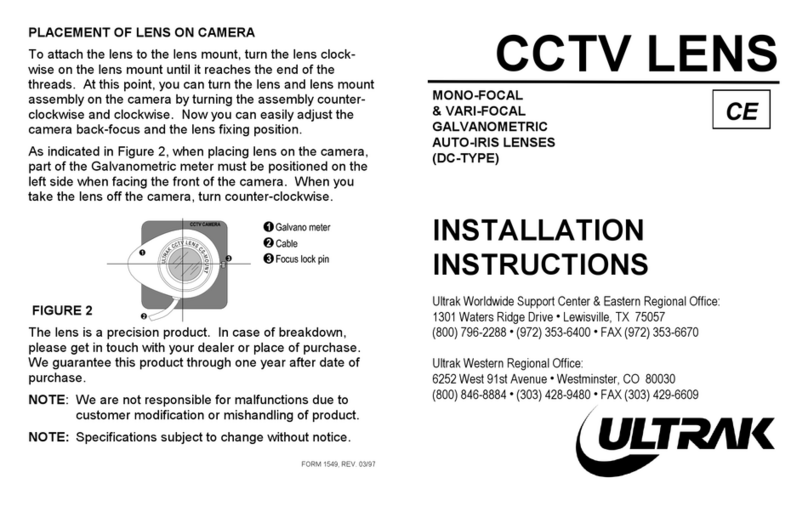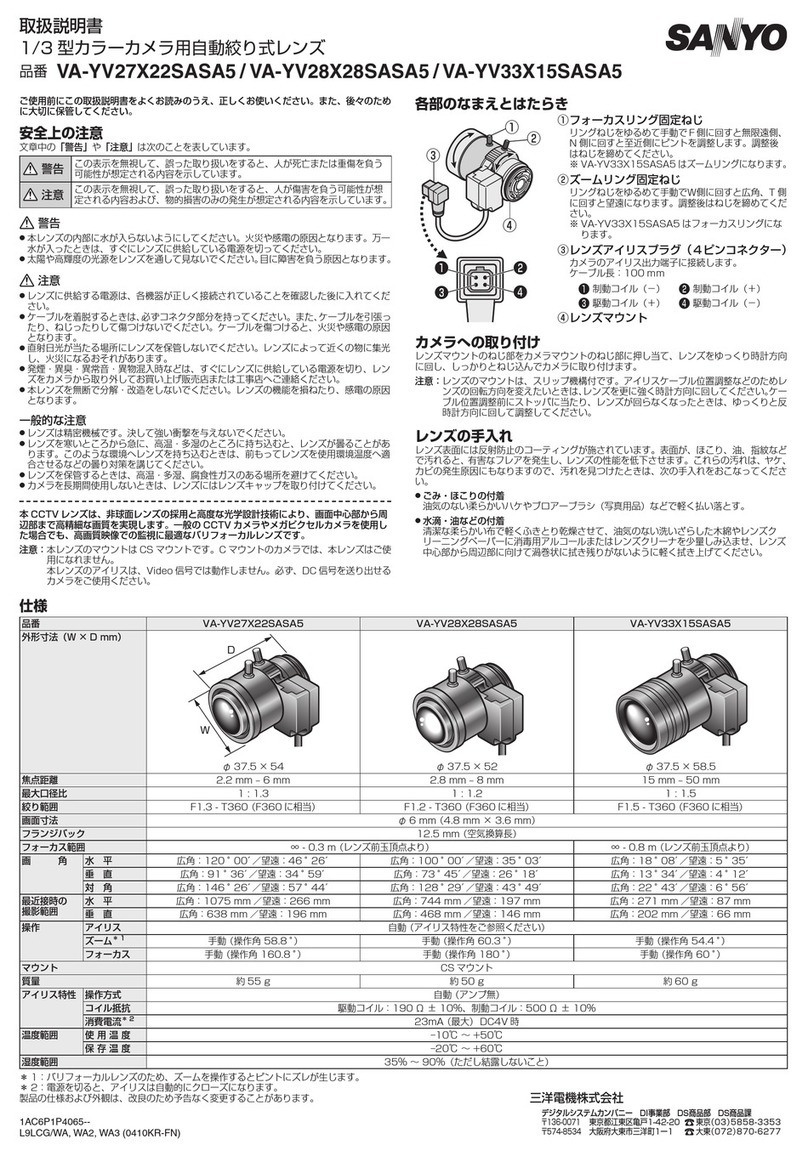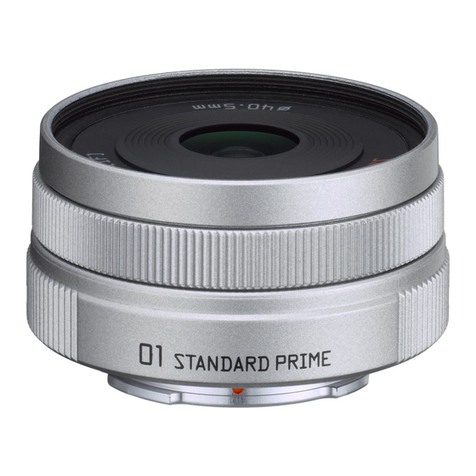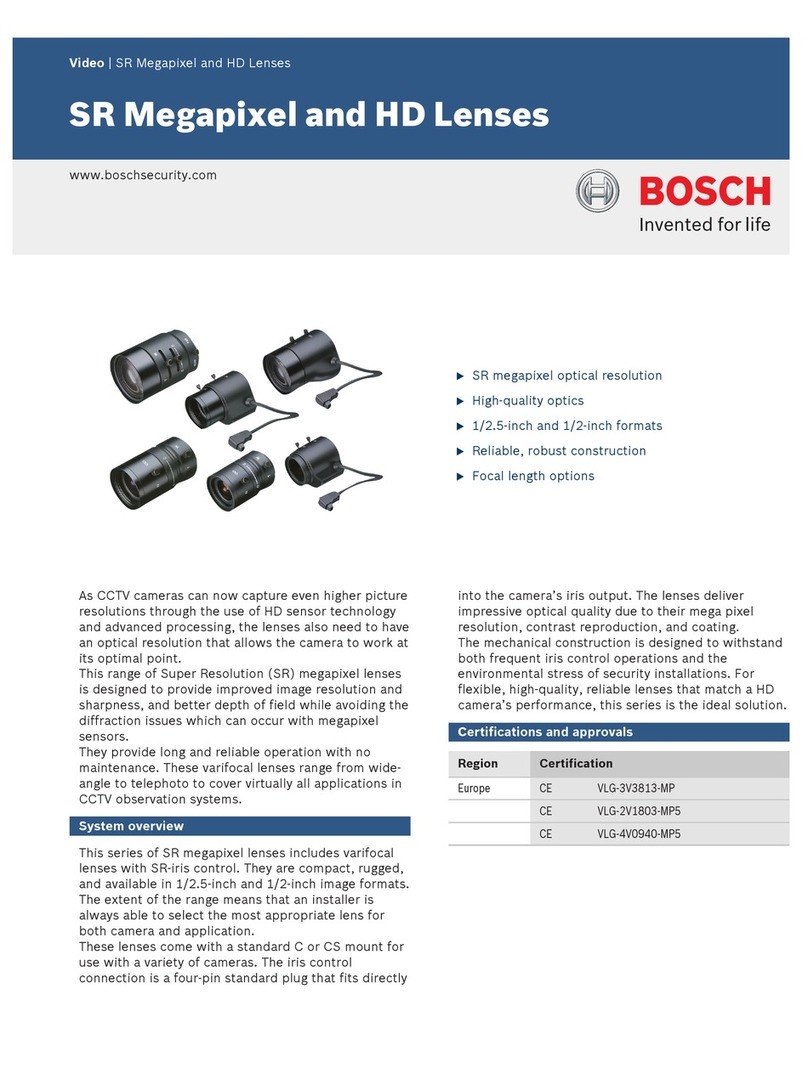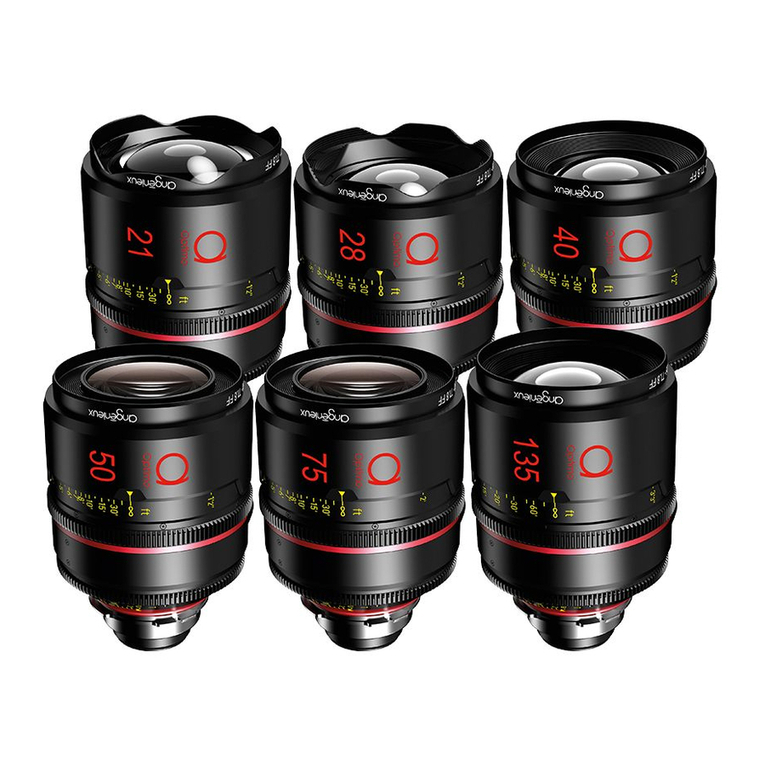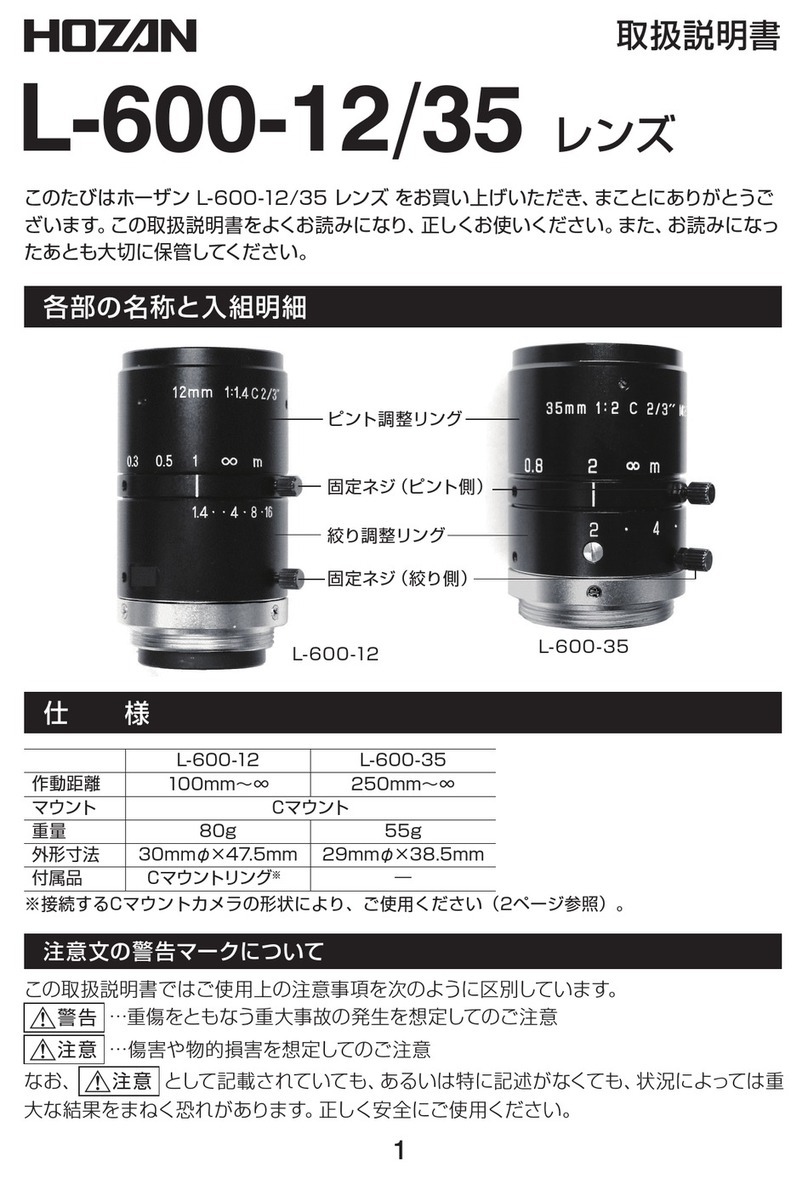Seed Breath-O Correct User manual

1 / 3
INSTRUCTIONS FOR USE
Breath-O Correct○
R
Please read carefully before use and keep this information for future use.
[Description]
1. Principles
Corneal topography is reshaped by direct wear of the contact
lens on the anterior segment of the eye. After removal, unaided
vision is improved.
2. Composition
Fluoride-containing methacrylate compound
Silicon-containing methacrylate compound
[Intended use]
The Breath-O Correct is indicated for overnight wear for
myopia and myopic astigmatism. It reshapes the cornea, and
provides improved vision after removing lenses.
[Indications]
Vision correction for myopia or myopic astigmatism.
[Instructions of use (Operation procedures, usage, etc.)]
1. Before handling lens
1) Cut your fingernails short and round before handling your
lenses.
2) Always wash your hands and fingers with soap, and rinse off
completely.
3) Do not wet your lens with saliva, bottled water or tap water.
4) Work over a table with a clean towel. Do not remove your
lenses over a sink.
5) Make sure your nails, fingertips and plunger do not touch your
eyes directly. They may make a scratch on your eyes.
2. Lens insertion
1) Take out your lens from the lens case, pour lens care products,
rub it, and wash out with lens care products. Use the same
procedure even if it is unused lenses.
2) Place your lens on the index finger.
3) Put a few drops of artificial tear eye-drops or a similar
substance on the concave side of your lens. Be careful not to get
air bubble at that time.
4) Put a mirror down and stare into it.
5) Open the eye wide using the thumb and index finger of the
other hand.
6) Bring your lens close to the eye slowly, and gently place your
lens on the iris of the eye.
7) After placing your lens on the iris, slowly release the fingers
that were opening the eye, and blink.
3. Lens removal
1) Scooping method
(1) Apply the artificial tear eye-drops or a similar substance to
the eye, and confirm that your lens is on the iris and
becomes movable.
(2) Press hairlines of the upper and lower eyelashes with both
index fingers.
(3) Lift the finger holding the upper eyelid and hold the top
edge of your lens with the upper eyelid. Gently lift the
finger holding the lower eyelid and remove your lens with
eyelids in a scooping manner.
(4) Rub your lenses by lens care products, wash out with lens
care products, and place to the lens case with full of lens
care products.
2) Suction cup method
(1) Apply the artificial tear eye-drops or a similar substance to
the eye, and confirm that your lens is on the iris and
becomes movable.
(2) Hold the suction cup by thumb and index finger of your
dominant hand.
(3) Open both eyes wide while looking in the mirror, and make
sure that your lenses are placed on your eyes.
(4) Lightly push the suction cup straight in the center of your
lens.
(5) Lower the suction cup and remove your lens from the eyes,
with attention not to close the eyes.
4. Lens wear schedule
1) Wearing cycle
(1) Wear your lenses longer than 5 hours as standard usage.
(2) The effects of visual acuity correction vary individually.
Follow the instructions of your Eye Care Practitioner and
be sure to comply with the lens wear schedule properly.
2) Resuming wearing lens after interruption
Receive eye examination before resuming lens wear in case of
discontinuing for a long time. Referring to the cycle above,
follow the instructions of your Eye Care Practitioner on the
lens wear schedule.
5. Maintenance
1) Lens care
(1) Always wash your hands and fingers with soap, and rinse
off completely before lens care.
(2) For lens care, using the compatible lens care products for
the orthokeratology contact lens, wash your lenses by
gently rubbing them and rinse them. Then, put the lens care
products into the lens case and immerse your lenses
completely in the solution.
(3) When using the lens care products, read the labels and
package inserts of lens care products and follow
instructions.
(4) Replace your lenses with new ones every two years as
standard usage, but please follow the instructions of your
Eye Care Practitioner about frequency.
2) Managing the lens case
(1) Be sure to use a dedicated lens case for the orthokeratology
contact lens.
(2) Replace the lens case with a new one every three months as
standard usage.
(3) Dispose the disinfectant solution from the lens case. Wash
and air dry the lens case completely.
6. Regular examination
1) If you experience even a slight abnormality, immediately
contact your Eye Care Practitioner for an eye examination.
2) Make sure to regularly receive eye examinations as instructed
by your Eye Care Practitioner and have him/her check if your
lenses can be used, even if you are wearing contact lenses
comfortably without any symptoms.
At bedtime
On waking up
Lens cleaning
Lens wear
Overnight wear
Waking up
Lens removal
Cleaning and soaking
the lenses

2 / 3
[Contraindications](REASONS NOT TO USE)
DO NOT USE the Breath-O Correct when any of the following
conditions exist:
1. Acute or subacute inflammation or infection of the anterior
segment of the eye.
2. Eye infections
3. Decreased corneal sensitivity
4. Severe insufficiency of lacrimal secretion (dry eyes).
5. Allergic reactions of ocular surfaces or adnexa that may be
induced or exaggerated by wearing contact lenses or use of lens
care products.
6. Signs of keratoconus or other corneal disorders
7. Pregnant or breast-feeding women or women planning to
conceive
8. Immune disorders (e.g., Acquired immune deficiency syndrome
and autoimmune disorders) or diabetes mellitus
9. Any eye disease, injury, or abnormality that affects the cornea,
conjunctiva or eyelids.
10. Redness of the eyes or irritated.
11. Patients who cannot follow the instructions given by an Eye
Care Practitioner.
12. Patients who cannot undergo regular examinations.
13. Patients who always need proper visual acuity at work and
who have difficulty in discontinuing their work when changes
in vision acuity occur.
14. Patients who has unstable corneal refractive power (radius of
curvature) measurement or irregular Meyer image (irregular
astigmatism)
[Warnings]
1. Read these instructions thoroughly prior to the use of contact
lenses and lens care products. If there are any unclear
explanations or contents, consult your Eye Care Practitioner
before use.
1) Breath-O correct should be used for overnight wear only.
2) Unaided vision cannot be corrected as intended if these lenses
are used improperly. The patient should adhere to the prescribed
schedule. When wear is discontinued, unaided vision will be
reduced in a few days.
3) Eye disorders including corneal endothelial cell loss or giant
papillary conjunctivitis may occur even when Breath-O correct
is used properly. The patient should visit the Eye Care
Practitioner for regular examinations irrespective of the
cognizance of any symptom.
4) Lens wear may increase the risks of eye disorders including
corneal ulcer, corneal infiltrates, keratitis, corneal edema,
corneal neovascularization, corneal erosion, corneal epithelium
disorder, conjunctivitis, allergic conjunctivitis, iritis and stye.
Therefore whenever a patient perceives any abnormality,
including lacrimation disorder, foreign body sensation, pain,
hyperemia, eye discharge, or changes in vision, or finds damage
to the lens, immediately discontinue lens wear and promptly
consult the Eye Care Practitioner.
2. Improper use of Breath-O correct or the care products may
cause serious eye disorders, including corneal ulcer, potentially
resulting in sight loss. Cleaning and storage of the lenses should
be properly conducted in accordance with the instruction
manual.
3. As for tasks where changes in visual acuity are related to
physical and mental risks, such as driving a car or motorcycle,
consult your Eye Care Practitioner and follow the instructions.
4. If you have worn a damaged lens or a lens has been damaged
during use, immediately contact your Eye Care Practitioner for
an eye examination even if you do not notice any symptoms.
[Precautions]
1. Precautions to ensure safety of your eyes
1) Before inserting your lenses in your eyes, examine your lenses
to make sure that they are not damaged, deformed, or scratched,
and are free of any foreign substances or dirt. Never use lenses
with any such defects.
2) Follow the instructions of your Eye Care Practitioner in regard
to the use of eye-drops.
3) Do not rub or press your eyes with force while wearing contact
lenses.
4) Use only lenses prescribed for yourself.
5) Never use well water or tap water to store your lenses. The
acanthamoeba in well water or tap water may lead to serious eye
disorders. Use the lens care products to store your lenses.
2. Precautions to protect your lenses from damage, deformation,
scratches, foreign bodies, and dirt
1) Cut your fingernails short with their tips round and smooth.
2) Wash your hands and fingers with soap and rinse off the soap
completely before handling your lenses.
3) Place a washed towel or handkerchief on a well-lit, clean
surface where you are going to handle your lenses.
4) It is best to insert your lenses before applying makeup.
5) Do not press, bend, or turn over your lenses with force.
6) Use the tips of your thumb and index finger to hold your lens
gently.
7) If your lens falls out of your eye, wet the tips of your fingers
and pick up your lens.
8) Do not rub or wipe your lenses with a handkerchief, spectacle
wipe, or tissue paper.
9) Do not get chemicals or oil, such as cosmetics, hair spray,
benzine, alcohol, or thinner, on your lenses.
10) Do not soak your lenses in hot water or leave them where they
may be subjected to high temperature.
11) Do not dehydrate your lenses.
12) Do not freeze your lenses.
13) Do not hit your lenses against the edge of the lens case, etc.
14) Do not use a lens case which can cause deformation of your
lenses.
15) Do not use your lenses to expand the lens holder when storing
your lenses in the holder of the lens case. Doing so may cause
damage or deformation of your lenses.
16) Do not open/close the cap of a lens care product or lens case
while holding your lens with fingers.
17) Always keep the lens case clean.
18) Do not use saliva to wet your lenses.
3. Other precautions
1) If you are hospitalized or recover from an illness or injury, you
may not be able to use lenses. Inform your doctor that you are
wearing lenses and follow their instructions.
2) Never process or alter your lenses.
3) Always insert the correct lens in each eye.
4) Pay special attention when applying eye-drops over the lenses.
The lenses may fall out easily.
5) If your eyes feel dry, blink your eyes intentionally.
6) Avoid operating a motor vehicle or machinery until you get
used to wearing your lenses.
7) Purchase replacement lenses regularly as instructed by your Eye
Care Practitioner. (It is said that lenses should be replaced with
new ones every two years as standard usage.)
8) Purchase replacement lens cases regularly.
9) Keep your lenses out of reach of children.
10) If an elderly user finds it difficult to insert/remove, or care for
lenses, consult an Eye Care Practitioner and follow the
instructions.
11) Physical conditions or status of the eyes due to illnesses,
medications, or eye-drops may affect contact lens wear, even if
they do not fall under the symptoms listed in
[Contraindications]. Consult your Eye Care Practitioner before
use. Also, the condition of contact lens wear may change after
starting to use lenses. Consult your Eye Care Practitioner for
details.
12) Check the eyes for hyperemia or unusual eye discharge by
looking into a mirror. Discontinue lens wear when any
abnormality is perceived, including foreign body sensation,
hyperemia, pain, and consult your Eye Care Practitioner.
Evaluation of suitability
Starting day of lens wear
The following day of starting
1 week after starting
2 weeks after starting
I month after starting
Every 3 months onwards
or on designated day
3 months after starting

3 / 3
13) Symptoms and measures to be taken.
(1) You may experience any of the following physiological
symptoms during the initial stage of contact lens wear. The
symptoms may resolve as your eyes become used to your
lenses (generally after a few weeks).
-- Minor foreign body sensation in your eyes
-- Excessive eye blinking
-- Ocular itching
-- Excessive lacrimation
-- Unusual eye discharge
-- Sensitivity to light
-- Unstable vision
-- Dizzy
(2) Even after getting used to your lenses, the symptoms described
below may appear. You should consult the Eye Care
Practitioner immediately when these symptoms are not
improved by the measures taken or when other symptoms
occur.
A) When a lens has a deficiency.
Symptoms
Possible causes
Measures to be taken
Pain
Lacrimation
Damage to the lens
or
Stains on the lens
Discontinue lens wear and
visit the Eye Care
Practitioner for
examination.
Difficulty in seeing
Strange sensation in the
eye
Deformation of the lens
or
Reversal of the lens
B) When an eye has a disease
Symptoms
Possible causes
Measures to be taken
Dry eye
sensation
Lack of lacrimation
Discontinue lens
wear and visit the
Eye Care
Practitioner for
examination.
Foreign body
sensation, pain,
or ocular itching
during lens wear
Contamination
with a foreign body
or
Eye injury
Pain or
hyperemia after
lens removal
Consult the Eye Care
Practitioner
immediately.
C) When lens usage is inappropriate
Symptoms
Possible causes
Measures to be taken
Strange
sensation in the
eye
Insufficient
cleaning
Wash the lens
thoroughly, e.g.,
wash by gently
rubbing it. If
symptoms persist
even after taking
measures, consult
the Eye Care
Practitioner.
Eye-stinging or
excessive
lacrimation
immediately
after lens wear
Stains on the lens
Wash and rinse the
lens thoroughly.
Check for
abnormalities in the
lens.
Residual lens care
products
(Insufficient
rinsing)
Rinse the lens
thoroughly.
D) When the prescription is inappropriate
Symptoms
Possible causes
Measures to be taken
Lens are often
displaced
Unfitting lens
curve
Discontinue lens wear
and visit the Eye Care
Practitioner for
examination.
Blurred vision
Diplopia
[Potential adverse events]
The objective findings or symptoms mentioned below may occur
with lens wear. Take necessary measures, as needed, including
discontinuing lens wear.
・corneal ulcer
・corneal neovascularization
・corneal desquamation
・superficial punctate keratopathy
・corneal staining
・corneal opacity
・corneal warpage(corneal irregular astigmatism)
・corneal foreign body
・papillary conjunctivitis
・allergic conjunctivitis
・conjunctival hyperemia
・iritis
・ciliary hyperemia
・stye
・dry eyes
・eye infection
・halos, glare, loss of visual contrast sensitivity
・dislocation of lens(lens decentration)
・damaged
・deformed
・inside-out
・dirt
[Storage and Duration of Use]
[Storage of unopened lenses]
Avoid direct exposure to sunlight and extreme heat.
Store the lens at room temperature.
[Aspects concerning maintenance and inspection]
At periodic intervals, visual examination of Breath-O contact
lenses should be conducted (scratches, stains, and adhesion of
foreign materials on the lens surface, and discoloration,
deformation, and damage) to determine continuous usability of the
product. When continuous use is difficult, take necessary actions
such as replacing the product.
The Breath-O Correct should be expired 6 years and 9
months after manufacturing date.
[Symbol Key]
The following symbols may appear on the label or on the
packaging:
Symbol
Definition
Caution and Attention,see instructions for
Use
Consult to Instructions for Use
Date of Manufacture
Lot Number/Batch Code
TRIAL
The device is intended only for the trial
lens.
F.T
Fitting Curve
T.P
Target Power
B.C
Base Curve
P
Power for contact lens
S
Lens size(Diameter)
October 2019, Printed in Japan
Other Seed Lens manuals

